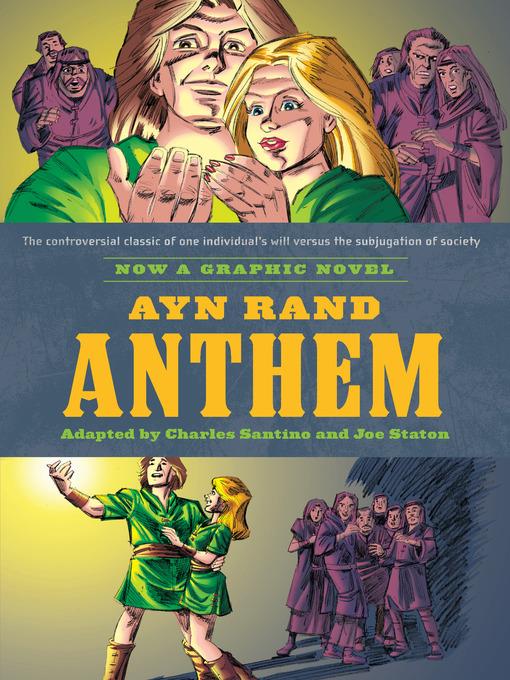
Ayn Rand's Anthem
The Graphic Novel
کتاب های مرتبط
- اطلاعات
- نقد و بررسی
- دیدگاه کاربران
نقد و بررسی

January 3, 2011
In a future where misguided egalitarianism has reduced a once-vibrant civilization to a handful of doctrinaire serfs living in the rubble of what once was, Equality 7-2521 rejects the mindless collectivism of his people to embrace individuality. His curiosity about the mysteries of the past is anathema to those selected to rule; Equality's rejection of his assigned menial role is if anything an even greater affront to his master. Forced by the lesser men around him to flee, Equality and his lover, Liberty 5-3000, find refuge in a conveniently preserved chalet, free to rediscover eternal truths suppressed by their totalitarian forefathers. Adapted from Rand's 1938 novella, Staton's art is oddly crude for such a veteran artist, but oddly well suited for Rand's clumsy, hectoring story. The product of a time when authoritarian regimes seemed destined to prevail, written by a refugee from the Russian revolution, Anthem might have been a valuable reminder of what happens when ideology trumps humanitarian concerns, but sadly, Rand was not up to the task; Santino and Staton do what they can with this dismal tribute to egotism, but the result is still a hard slog.

December 1, 2010
A graphic novel for devotees of Ayn Rand.
With its men who have become gods through rugged individualism, the fiction of Ayn Rand has consistently had something of a comic strip spirit to it. So the mating of Rand and graphic narrative would seem to be long overdue, with her 1938 novella better suited to a quick read than later, more popular work such as The Fountainhead (1943) and the epic Atlas Shrugged (1957). As Anthem shows, well before the Cold War (or even World War II), Rand was railing against the evils of any sort of collectivism and the stifling of individualism, warning that this represented a return to the Dark Ages. Here, her allegory hammers the point home. It takes place in the indeterminate future, a period after "the Great Rebirth" marked an end of "the Unmentionable Times." Now people have numbers as names and speak of themselves as "we," with no concept of "I." The hero, drawn to stereotypical, flowing-maned effect by illustrator Staton, knows himself as Equality 7-2521 and knows that "it is evil to be superior." A street sweeper, he stumbles upon the entrance to a tunnel, where he discovers evidence of scientific advancement, from a time when "men knew secrets that we have lost." He inevitably finds a nubile mate. He calls her "the Golden One." She calls him "the Unconquered." Their love, of course, is forbidden, and not just because she is 17. After his attempt to play Prometheus, bringing light to a society that prefers the dark, the two escape to the "uncharted forest," where they are Adam and Eve. "I have my mind. I shall live my own truth," he proclaims, having belatedly discovered the first-person singular. The straightforward script penned by Santino betrays no hint of tongue-in-cheek irony.
A Rand primer with pictures.
(COPYRIGHT (2010) KIRKUS REVIEWS/NIELSEN BUSINESS MEDIA, INC. ALL RIGHTS RESERVED.)

March 15, 2011
In a letter to Walt Disney, the controversial, radically individualist Rand (The Fountainhead; Atlas Shrugged) wrote that if a film were made of her dystopian parable Anthem (1938, revised 1946), she would prefer it to be done "in stylized drawings, rather than with living actors." She gets her wish, sort of, in this graphic adaptation. In a future society so collectivist that its language has no first-person singular pronoun and so primitive that it only recently began using candles, street sweeper Equality 7-2521 begins sneaking away at night to pursue his forbidden scientific ambitions and discovers not only an ancient technological secret but also the value of independence. With the girl Liberty 5-3000, he also discovers love. VERDICT Santino relates the story in the present tense, robbing some of its mythic feel. Staton's unvarying three-panel page layouts fail to emphasize the story's more dramatic moments, and his cartoony style (with monochrome art rendered in uninked, sometimes sketchy pencils) fails to match Rand's fierce and poetic language. This short Anthem is hardly forbidding as a literary work--readers should stick with the original.--S.R.
Copyright 2011 Library Journal, LLC Used with permission.

























دیدگاه کاربران